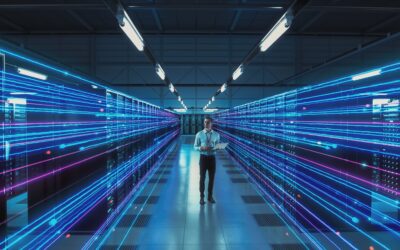IT Teams face six significant threats and challenges that jeopardize growth.
Rapid change means mission-critical IT systems and users are constantly plagued with factors that hinder performance and increase risk. Everything connected to the internet and people is a moving target.
Does your organization have a framework for identifying operating obstacles? Gaining visibility into modern computing infrastructure is challenging because IT systems are all over the place:
- In the office
- In the cloud
- At home
- On mobile devices
- Over Wi-Fi networks
- Across anything with an IP address
This decentralization makes it increasingly challenging for all applications to be available, up-to-date, synchronized, and accessible by all the right people at the right time while keeping all the wrong people out.
Since many organizations are unaware of gaps, the stage is set (and continuously re-set) for discord.
Root Causes Affecting IT Teams
IT infrastructure can be intimidating, impossible to keep up with, and boring to many people, even IT Teams.
If everything seems to be working and users are not complaining, many organizations prefer to leave well enough alone. AKA “We’re happy!”
Technology marketing is notorious for overpromising and oversimplifying. Plug and play. Set it and forget it. Neither claim is valid. Anything with an IP address requires babysitting.
IT services are often sold as products, with too much emphasis on hardware, software, and cloud apps versus a process.
The IT Assessment Process Is Broken
Technology decisions are usually relegated to internal resources who have other primary job responsibilities:
- Director of Operations
- IT Applications Specialist
- CFO
- Finance Director
- Controller
- Someone who happens to be adept at a particular line of business application
There’s a tendency to let third-party IT providers do their thing without supervision.
It’s nearly impossible to provide oversight on the previous two points because most people don’t know what questions to ask, nor do they have the tools to administer meaningful checks and balances.
If the following six evergreen threats and challenges keep your IT Team on edge, you’re not alone.
Threat / Challenge #1
The Explosion of Cybercrime
Cybercrime Magazine projects cybercrime will cost the world $10.5 trillion annually by 2025.
- 35% of computers worldwide have Malware. (Microsoft)
- Malware opens the door for ransomware which has an average remediation cost of more than $622,597 per incident. (Sophos)
- Human error causes 95% of cyber breaches.
- Many organizations have a suite of next-generation cybersecurity tools but don’t know how to manage the nuances.
As per Tony Fergusson, CISO of Zscaler, “In the age of the cloud, updates, and features are being pushed constantly. That means configuring a new security tool once and stepping away isn’t enough. Because new functions can disrupt a business’s operations in ways unforeseeable to a vendor, they are often turned off by default when first released. To be their most effective, security tools must be reconfigured regularly.”
Threat / Challenge #2
Expanding Regulatory and Compliance Requirements
“Regulators are relentlessly pursuing what they perceive to be “weak links” within risk programs and coverage. Regulatory agencies in 2023 will continue executing against their broad and ambitious agendas,” notes Amy Matsuo, Principal, and Leader, Regulatory & ESG Insights, KPMG, LLP
- CEOs, investors, board members, employees, and clients are increasingly concerned with cyber risk exposure.
- Businesses are scrambling to stay ahead of new, evolving, and confusing compliance mandates.
- There is no such thing as 100% compliance or security. However, early detection, response, and documented proof of due care will always lower your liability.
- Many organizations have poorly configured networks, end-of-life infrastructure, and data backups that are not working or even being tested to verify success.
- The Biden Administration just introduced a new national security strategy, shifting liability for cyber failures to software companies.
Learn More: IT Security Frameworks and Standards
Threat / Challenge #3
The Growth of Mobility Solutions and Hybrid Work
COVID-19 triggered a work-from-home revolution powered by the cloud and best-in-class mobility solutions. A 100% return to the pre-pandemic work model is unlikely.
In The Future of Hybrid Work: 5 Key Questions Answered With Data, Ben Wigert observes:
- Pre-pandemic, 8% of workers preferred 100% remote work. Now, 32% prefer 100% remote work.
- Pre-pandemic, 32% of workers preferred a hybrid option. That figure is presently 59%.
- Pre-pandemic, 60% of workers preferred to work onsite 100% of the time. Now, only 9% prefer to work 100% onsite.
Other trends are forcing IT teams to pivot:
- Smartphones and tablets create a 24/7 “always on” work environment.
- Younger people are the fastest-growing segment of the workforce. This tech-savvy demo wants connectivity and flexibility. And they’ll leave your company to work for someone else if you don’t make it easy for them to do their jobs.
- Decentralized technology is more challenging to integrate and secure.
- Technology is now a free or inexpensive consumer product allowing anyone to find and download unvetted apps quickly.
- If employer-approved technology is not working well, employees will use applications that create additional cyber risk and jeopardize the retention of intellectual capital and trade secrets.
Threat / Challenge #4
A Growing Pipeline of Disruptive Technology
As IT Teams struggle to manage standard IT infrastructure, a barrage of next-generation technologies threaten existing products, business models, and markets with obsolescence.
Automation is transforming manufacturing, healthcare, and logistics by replacing human workers with robots.
Applications like Artificial Intelligence and Machine Learning allow machines to perform tasks and learn from data to improve performance without human intervention.
Chatbots and Smart Assistance are taking over routine customer service tasks and lowering operating costs.
ChatGPT will even try to write a blog for you. If you’re a stickler for quality, please proceed with caution.
Innovation and Unknowns
3D Printing is changing manufacturing by creating three-dimensional objects from digital files, affecting multiple industries including, but not limited to healthcare, automotive, and aerospace.
Blockchain, the underlying platform for Bitcoin, is a digital currency, upending traditional banking and supply chain management.
5G internet technology delivers faster and more reliable internet for streaming video and downloading large files, opening the door for innovation and a few unknowns.
Industry Transformation
Advanced Virtual Reality is challenging legacy TV and movie experiences by immersing users in realistic digital environments, impacting entertainment, video games, education, and professional development.
Nanotechnology is manipulating matter on an atomic scale, creating materials and devices with unimaginable features and functionalities.
Big Data is capturing granular client and operational insights to improve efficiency, customize offerings, and sometimes compromise personal privacy.
Quantum Computing is overpowering traditional computers by processing data and tackling complex problems with unprecedented efficiency.
Learn More: Disruptive Technology
Threat / Challenge #5
Worldwide Staffing and Skill Shortages
Korn Ferry reports that by 2030, more than 85 million jobs could go unfilled because there aren’t enough skilled people to take them.
This specialization gap affects all industries, especially the worldwide IT staffing shortage. According to one Gartner Study, 64% of IT executives say the talent shortage is the barrier keeping them from adopting emerging technologies.
These two forces remind me of a crumbling and congested interstate, overburdened with unforeseen additional traffic from new vehicles and sideroads. To add intrigue to instability:
- People are changing jobs more frequently.
- Employees arriving at new jobs must be properly and efficiently onboarded with the right productivity tools on day one. Many organizations don’t have this figured out, and it creates a negative and lasting first impression.
- The engineers at your MSP will leave to make $15K more at a better-run MSP. If you have grown to rely on one person at your IT services provider, the departure of this crucial resource creates a single point of failure.
Threat / Challenge #6
Mergers & Acquisitions
Mergers and acquisitions drive consolidation as larger MSPs buy smaller ones.
- Smaller single-location providers can’t keep up, while larger providers may have difficulty integrating acquisitions into a smooth, repeatable process.
- IT teams that work with MSPs may experience quality of service problems.
- With larger entities making multiple acquisitions, it isn’t easy to integrate disparate management support systems from multiple MSP purchases.
- Acquiring companies are laying off employees, so your IT team may lose some of its favorite vCISOs, system engineers, vCIOs, cloud architects, and project managers.
- Mergers and acquisitions in all industries mean IT teams everywhere will be reorganized and possibly displaced.
Thought Starters for IT Teams
Turning threats and challenges into opportunities starts with asking tough questions:
- Does our IT reporting convey accountability to our executive team, investors, board members, employees, clients, and vendor partners?
- How do we objectively measure the effectiveness of our IT team?
- Are we resisting third-party IT assessments for political reasons?
- If everyone in the IT department suddenly left, could our organization continue operations without hiccups?
Schedule a free consultation if you need assistance eliminating blind spots and formulating new questions.



